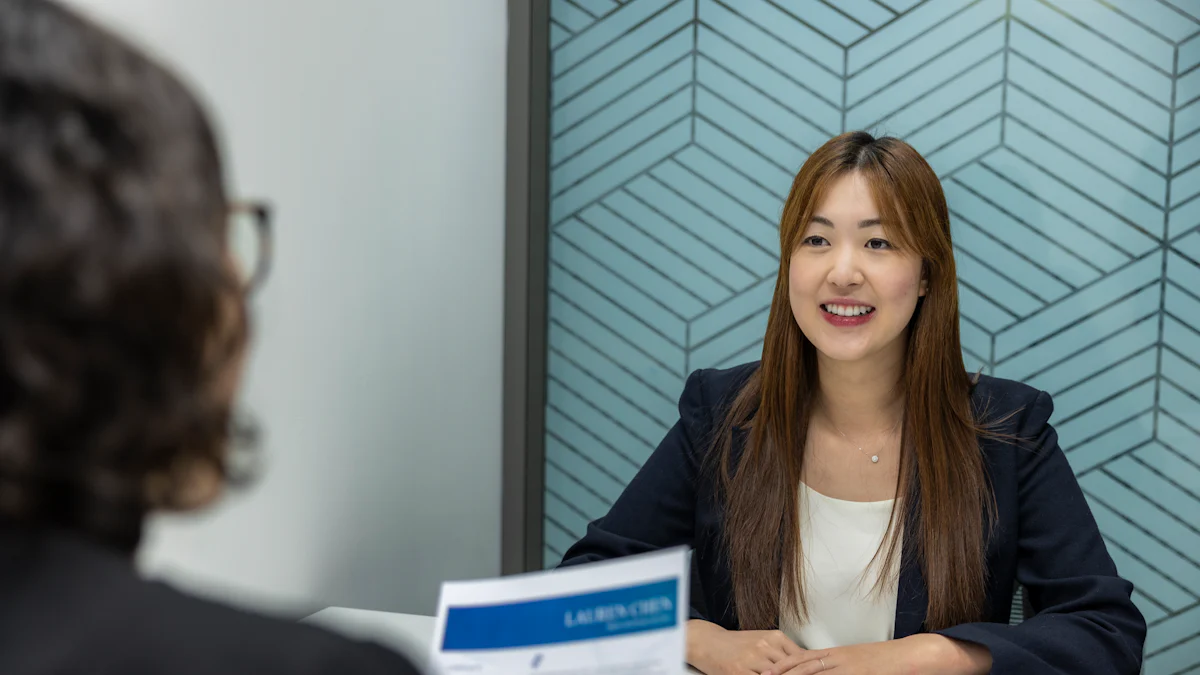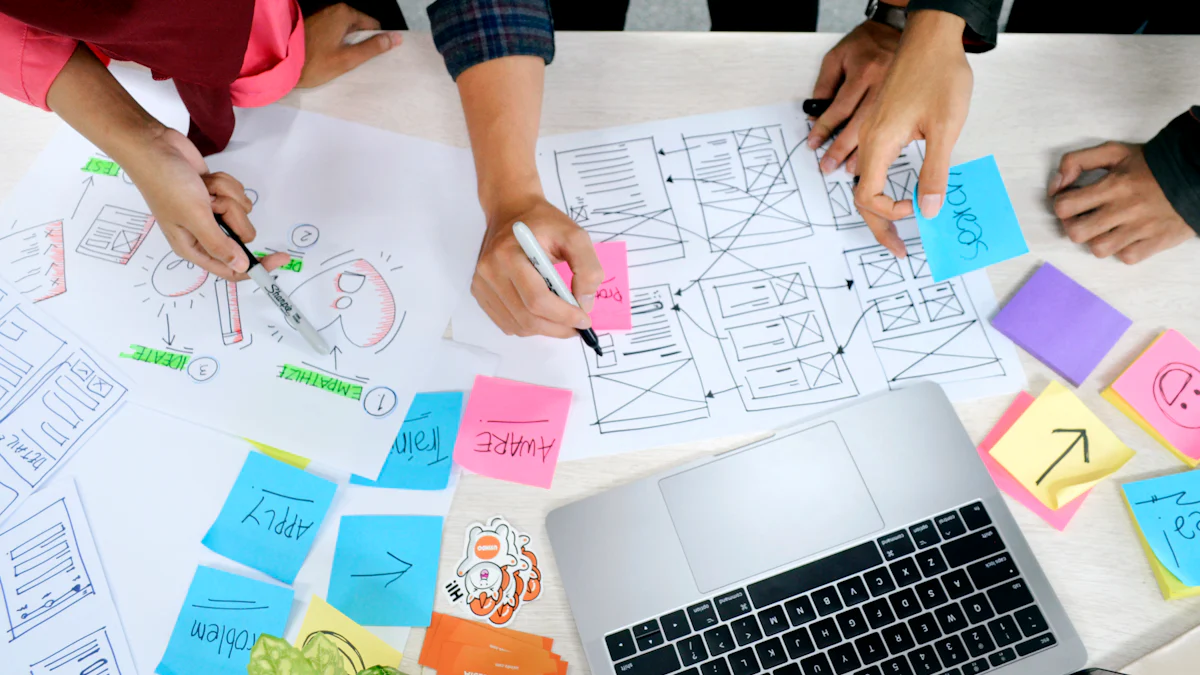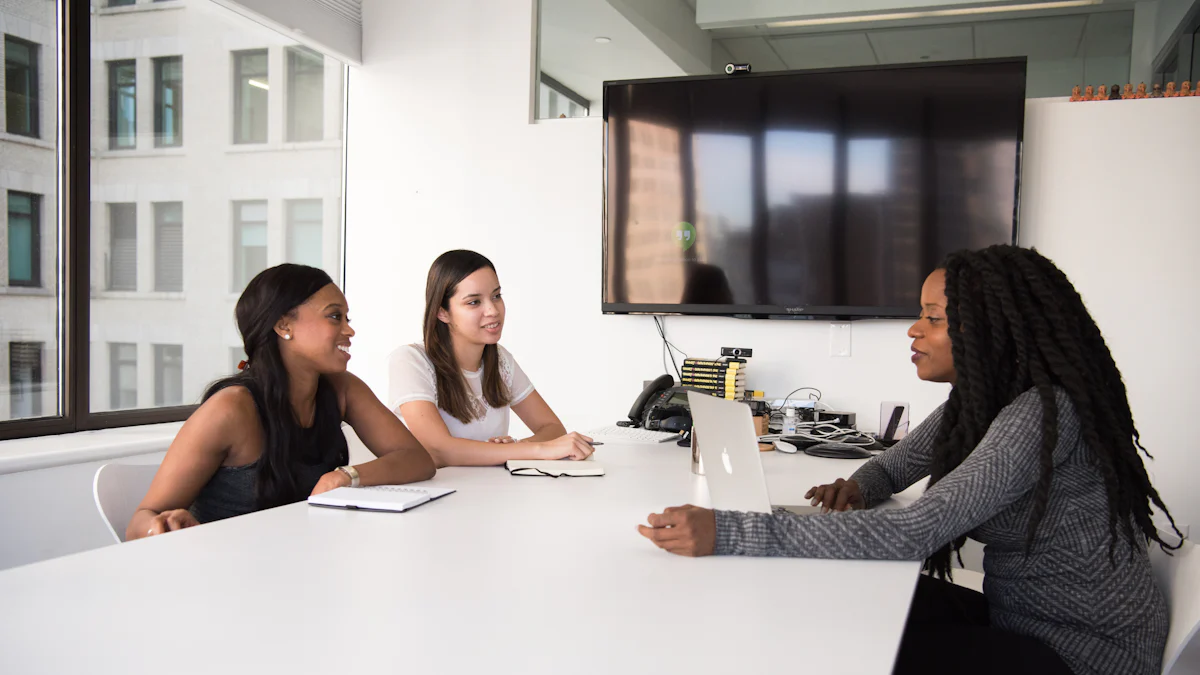How to Prepare for a Product Designer Interview in 2025
Try Aihirely for
Smarter Interview Prep
Experience real-time AI support tailored to your Resume.
Boost your confidence and ace every question with
AI Mock Interview.

Image Source: pexels
Landing a product designer role takes more than just creativity. You need to show you’re a problem solver, a team player, and someone who thrives on feedback. Companies want designers who can think critically and communicate their ideas clearly. In fact, 70% of mentors say communication is the top skill for designers, followed by critical thinking at 62%. Collaboration and problem-solving are also high on the list.
When you prepare for your interview, focus on showcasing these skills. Whether it’s through your portfolio or how you answer questions, let your strengths shine. This product designer interview article will help you feel confident and ready to impress.
Key Takeaways
-
Learn about the company’s goals and values to match your answers.
-
Pick projects for your portfolio that fit the company’s work.
-
Keep up with new design tools and trends to show leadership.
-
Practice answering common questions and explain how you solve problems.
-
Write a thank-you email after the interview to show interest.
Research and Preparation

Image Source: unsplash
Understand the Company and Role
Research the company’s mission, values, and design culture.
Start by diving into the company’s mission and values. What drives their work? What principles guide their design decisions? Understanding these aspects helps you align your answers and portfolio with their expectations. For example, if a company emphasizes user research, you can highlight your experience in that area. This also allows you to ask thoughtful questions during the interview, like how their design culture supports collaboration or innovation. It’s not just about impressing them—it’s about making sure their philosophy matches your career goals.
Study the job description to identify key skills and responsibilities.
The job description is your cheat sheet. It tells you exactly what the company is looking for. Pay attention to the required skills and responsibilities. Are they seeking expertise in wireframing, prototyping, or user research? Tailor your preparation to showcase these abilities. If they mention collaboration with cross-functional teams, think of examples where you’ve done this successfully. By aligning your skills with their needs, you’ll show them you’re the perfect fit.
Tailor Your Portfolio to the Role
Select projects that align with the company’s industry or design challenges.
Your portfolio isn’t just a collection of your best work—it’s a tool to tell your story. Choose projects that reflect the company’s industry or the challenges they face. For instance, if they’re in e-commerce, include a project where you improved a shopping experience. Keep it focused. Experts recommend showcasing around eight pieces, each with a clear objective, your role, and the results. A mix of digital and physical portfolios can also make you stand out.
Highlight your design process and problem-solving approach.
A strong portfolio doesn’t just show the final product—it walks the viewer through your journey. Include case studies that explain your thought process, from research to testing. Designers like Alex Lakas and Olivia Truong excel at this by presenting detailed yet minimalistic case studies. Whether it’s a technical challenge or a creative one, let your problem-solving skills shine. This approach not only demonstrates your expertise but also gives interviewers a glimpse into how you think.
Stay Updated on Industry Trends
Familiarize yourself with current design tools and methodologies.
The design world evolves quickly, and staying updated is crucial. Make sure you’re comfortable with the latest tools like Figma, Sketch, or AI-powered design platforms. Mastering design systems can also set you apart by showing you value efficiency and consistency. Employers want versatile designers who can adapt to new challenges, so keep exploring and learning.
Understand emerging trends in product design for 2025.
The future of design is exciting, and 2025 is no exception. Trends like amplified empathy and relentless curiosity are shaping the industry. Designers are expected to create deeply personal experiences while staying curious about new tools and techniques. AI is also playing a bigger role, helping designers focus more on creativity. By understanding these trends, you’ll show that you’re not just keeping up—you’re ready to lead.
Portfolio and Resume Tips
Showcase Your Design Process
Include case studies that demonstrate your design thinking and problem-solving.
Your portfolio should tell a story, not just display pretty visuals. Case studies are your chance to show how you think and solve problems. Start with an engaging title that sets the context. Include details like the team you worked with, your role, and the timeline. Clearly state the problem you tackled and the goals you aimed to achieve. Walk the viewer through your process step by step—research, sketches, wireframes, prototypes, and iterations. Wrap it up with the outcomes and lessons learned. This structure not only highlights your skills but also makes your work relatable and memorable.
Highlight how you approached user research, prototyping, and testing.
Don’t just say you did user research—show it. Include artifacts like surveys, user personas, or usability test results. Explain the challenges you faced and how you overcame them. For example, did you discover a surprising user need during testing? How did you adapt your design? Share the tools and methods you used, and don’t forget to mention the impact of your work. This level of detail helps interviewers see the value you bring to the table.
Emphasize Your Personal Contributions
Clearly outline your role in team projects and individual contributions.
When showcasing team projects, make your role crystal clear. Did you lead the research phase? Were you responsible for prototyping? Summarize your contributions in a way that highlights your unique skills. You can even include peer reviews or feedback to back up your claims. This transparency builds trust and shows you’re a team player who knows their strengths.
Use metrics to show the impact of your designs.
Numbers speak louder than words. Use metrics to quantify your impact. For instance, did your design improve user satisfaction by 20%? Did it reduce task completion time by 15 seconds? Present these results visually, like in a chart or infographic, to make them stand out. A strong narrative combined with data can make your portfolio unforgettable.
Keep It Clean and Professional
Use a simple, visually appealing layout for your portfolio.
Your portfolio should be as easy to navigate as a well-designed app. Stick to a clean layout with modern fonts and a touch of color to guide the viewer’s eye. Avoid overly artistic designs that can distract from your work. Remember, the goal is to make your projects shine, not the portfolio itself.
Ensure your resume is concise and tailored to the role.
Your resume is your first impression, so make it count. Keep it concise—one page is ideal. Use keywords from the job description to pass applicant tracking systems. Highlight your accomplishments with impact statements, not just a list of tasks. For example, instead of saying “Designed wireframes,” say “Created wireframes that improved user engagement by 25%.” This approach shows you’re results-driven and focused on adding value.
Practicing Interview Questions
Prepare for Common Questions
Be ready to discuss your design process and favorite projects.
Interviewers love to hear about your design process and the projects you’re most proud of. Be prepared to walk them through your approach step by step. Start with how you identify user needs, then explain how you brainstorm ideas, create prototypes, and test your designs. Don’t just focus on the final product—share the story behind it. For example, you might talk about how you used user feedback to refine a design or how you solved a tricky problem during prototyping. This gives interviewers a clear picture of how you think and work.
Practice answering questions about challenges and how you overcame them.
Every designer faces challenges, and interviewers want to know how you handle them. Think about a time when you received tough feedback or struggled to meet a deadline. How did you adapt? For instance, one designer improved a stapler design after receiving client feedback by taking responsibility and streamlining the process. Another focused on understanding client needs during a branding project, which led to a successful collaboration. Share these kinds of stories to show your problem-solving skills and resilience.
Anticipate Role-Specific Questions
Prepare for questions about user research, wireframing, and prototyping.
Role-specific questions often dive into the technical side of design. Be ready to explain how you conduct user research, create wireframes, and build prototypes. For example, you might describe how you use tools like Figma or Sketch to design for both web and mobile platforms. Highlight your methods for usability testing and how you ensure accessibility for all users. These details show you’re not just creative—you’re also methodical and user-focused.
Be ready to discuss how you collaborate with cross-functional teams.
Collaboration is a big part of product design, so expect questions about working with developers, marketers, and other team members. Share examples of how you’ve built trust and fostered communication within a team. Maybe you used tools like Slack or Asana to keep everyone aligned or set clear expectations to avoid confusion. Proactive project management and teamwork are key, so let your experience shine here.
Practice Behavioral Questions
Use the STAR method (Situation, Task, Action, Result) to structure your answers.
Behavioral questions can feel tricky, but the STAR method makes them easier. Start by describing the situation and task, then explain the actions you took and the results you achieved. For example, if you handled tight deadlines, talk about how you prioritized tasks and delivered a successful design. This structure keeps your answers clear and impactful.
Share examples of how you handle feedback and tight deadlines.
Feedback and deadlines are part of every designer’s life. Show how you embrace feedback to improve your work. Maybe you adjusted a design based on user testing results or worked with a client to refine their vision. When it comes to deadlines, share how you stay organized and focused under pressure. These examples highlight your adaptability and professionalism.
Preparing for the Interview Day

Image Source: unsplash
Plan Your Logistics
Test your technology setup for virtual interviews.
If your interview is virtual, your tech setup can make or break the experience. Take time to test everything beforehand to avoid last-minute hiccups. Here’s a quick checklist:
-
Select the Right Platform: Make sure you’re familiar with the video conferencing tool the company uses. Whether it’s Zoom, Google Meet, or Microsoft Teams, test it out in advance.
-
Test Audio and Video: Check your microphone and camera to ensure they work properly. A quick test call with a friend can help you spot any issues.
-
Create a Professional Setting: Choose a quiet, well-lit space with minimal distractions. Good lighting and a clean background can leave a strong impression.
These small steps show you’re prepared and serious about the opportunity.
Arrive early or log in a few minutes before the scheduled time.
Punctuality speaks volumes about your professionalism. For in-person interviews, aim to arrive 10–15 minutes early. This gives you time to settle in without making the interviewer feel rushed. For virtual interviews, log in 5 minutes early to test your setup and get comfortable. Being late, even by a minute, can disrupt the flow and leave a negative impression. A little planning goes a long way in setting the right tone.
Set the Right Mindset
Practice mindfulness or breathing exercises to stay calm.
Feeling nervous? That’s completely normal. Practicing mindfulness or simple breathing exercises can help calm your nerves. Take slow, deep breaths and focus on releasing tension from your body. You can also try scanning your body for areas of stress and relaxing them one by one. These techniques not only reduce stress but also help you stay present and focused during the interview.
Mindfulness has other benefits too. It improves self-awareness, enhances communication, and helps you present yourself authentically. A calm mind is a confident mind.
Visualize a successful interview to boost confidence.
Visualization is a powerful tool to build confidence. Picture yourself walking into the interview room (or logging into the call) with a smile. Imagine answering questions with clarity and enthusiasm. Recall a time when you nailed a presentation or solved a tough problem—use that memory to fuel your confidence. Positive affirmations like “I’ve got this” can also reinforce your mindset. By focusing on success, you’ll push aside doubts and walk in feeling ready to shine.
Dress Professionally
Choose attire that aligns with the company’s culture.
Your outfit says a lot about you before you even speak. Research the company’s culture to decide what to wear. A tech startup might lean toward smart casual, while a corporate firm may expect formal attire. When in doubt, it’s better to be slightly overdressed than underdressed. Dressing appropriately shows respect for the company and the interview process.
Ensure you look polished and presentable.
No matter the dress code, looking polished is key. Iron your clothes, check for stains, and make sure everything fits well. For virtual interviews, pay attention to how you appear on camera. Good lighting and a neat appearance can make a big difference. When you look your best, you’ll feel more confident—and that confidence will shine through.
Asking Questions and Following Up
Prepare Thoughtful Questions
Ask about the team’s design process and collaboration style.
Asking the right questions during your interview shows genuine interest and helps you understand if the role is a good fit. Focus on the team’s design process and how they work together. For example, you could ask:
-
What recent design projects has the team worked on, and what challenges did they face?
-
How does user research, testing, and iteration shape the design process?
-
How does the team collaborate with other departments like product management or engineering?
These questions not only highlight your curiosity but also give you insight into the company’s workflow. You can also explore their design culture by asking how they encourage innovation or take risks. This helps you gauge whether their approach aligns with your values and working style.
Inquire about opportunities for growth and learning.
Growth opportunities are key to long-term job satisfaction. Ask about how the company supports professional development. For instance, you might say, “What resources or programs does the company offer for skill-building?” or “Are there opportunities to take on leadership roles within the team?” These questions show you’re proactive about your career and eager to contribute to the company’s success. Plus, they help you understand how the company invests in its employees.
Follow Up After the Interview
Send a personalized thank-you email to your interviewers.
A thank-you email is a small gesture that leaves a big impression. Send it within 24 hours of your interview to show your appreciation and enthusiasm. Mention specific details from your conversation, like a project or topic you discussed. For example, you could write, “I enjoyed learning about your team’s approach to user research and how it impacts business outcomes.” Keep the tone professional yet warm. Avoid generic phrases like “Thanks for your time” without adding any personal touch. This email reinforces your interest in the role and keeps you top of mind.
Reiterate your interest in the role and highlight key points from the interview.
Use the thank-you email to emphasize why you’re excited about the position. Briefly restate how your skills align with the company’s needs. For instance, you might say, “I’m particularly excited about the opportunity to contribute to your innovative design culture and collaborate with cross-functional teams.” Highlighting key points from the interview shows you were engaged and attentive. It’s a simple yet effective way to stand out from other candidates.
Preparing for a product designer interview in 2025 is all about showing your best self. You’ve got to research the company, tailor your portfolio, and practice answering questions. These steps help you stand out and feel confident.
Remember, every interview is a chance to grow. Even if things don’t go as planned, you’ll learn something valuable. Trust your preparation, stay positive, and keep improving. This product designer interview article is your guide to success—use it to shine in your next opportunity!
FAQ
What should I include in my product design portfolio?
Focus on quality over quantity. Include 6-8 projects that showcase your design process, problem-solving skills, and impact. Highlight user research, prototyping, and testing. Add metrics to show results. Keep it clean and easy to navigate. Your portfolio should tell your story.
How do I prepare for behavioral interview questions?
Use the STAR method: Situation, Task, Action, Result. Share real examples of challenges you’ve faced, how you handled them, and the outcomes. Practice telling these stories confidently. Show how you adapt to feedback, meet deadlines, and collaborate with teams.
What tools should I know for a 2025 product design role?
Stay updated with tools like Figma, Sketch, and AI-powered platforms. Learn design systems for consistency and efficiency. Familiarize yourself with usability testing tools and accessibility standards. Employers value designers who adapt to new technologies and trends.
How can I calm my nerves before an interview?
Try mindfulness or breathing exercises. Take slow, deep breaths to relax. Visualize yourself succeeding in the interview. Positive affirmations like “I’m prepared and capable” can boost confidence. A calm mind helps you focus and communicate effectively.
Should I follow up after the interview?
Absolutely! Send a thank-you email within 24 hours. Mention specific points from the interview and reiterate your interest in the role. Keep it professional but personal. This small gesture leaves a lasting impression and shows your enthusiasm.
